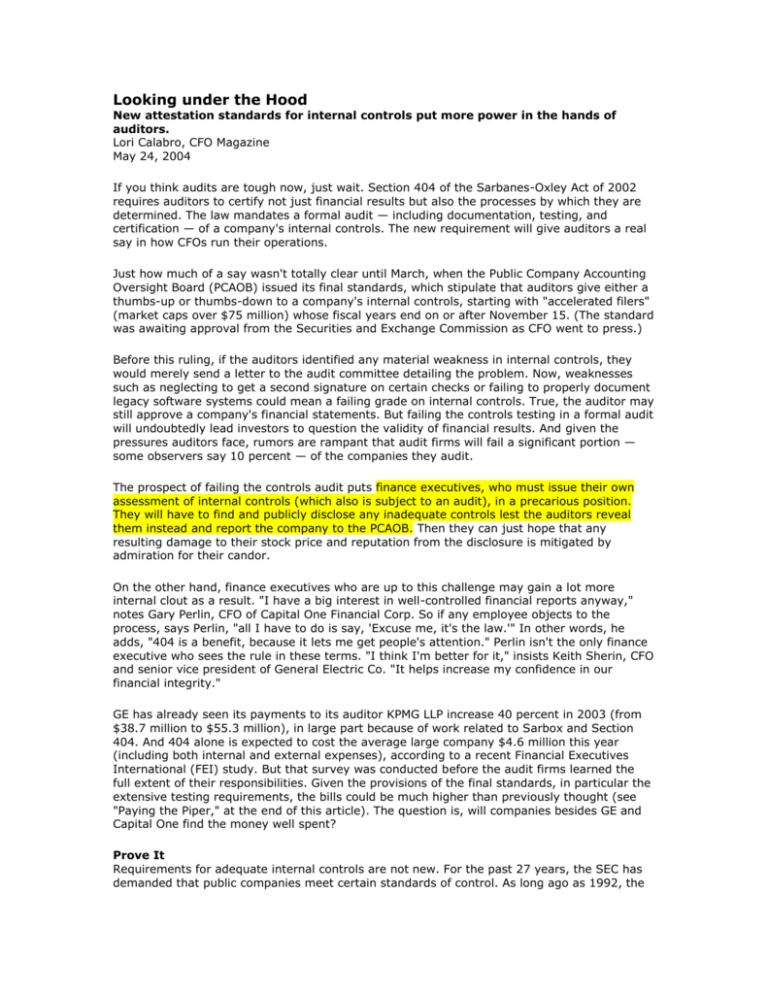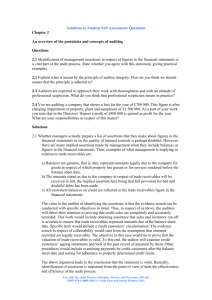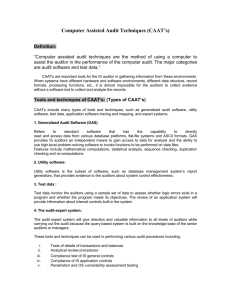
Looking under the Hood
New attestation standards for internal controls put more power in the hands of
auditors.
Lori Calabro, CFO Magazine
May 24, 2004
If you think audits are tough now, just wait. Section 404 of the Sarbanes-Oxley Act of 2002
requires auditors to certify not just financial results but also the processes by which they are
determined. The law mandates a formal audit — including documentation, testing, and
certification — of a company's internal controls. The new requirement will give auditors a real
say in how CFOs run their operations.
Just how much of a say wasn't totally clear until March, when the Public Company Accounting
Oversight Board (PCAOB) issued its final standards, which stipulate that auditors give either a
thumbs-up or thumbs-down to a company's internal controls, starting with "accelerated filers"
(market caps over $75 million) whose fiscal years end on or after November 15. (The standard
was awaiting approval from the Securities and Exchange Commission as CFO went to press.)
Before this ruling, if the auditors identified any material weakness in internal controls, they
would merely send a letter to the audit committee detailing the problem. Now, weaknesses
such as neglecting to get a second signature on certain checks or failing to properly document
legacy software systems could mean a failing grade on internal controls. True, the auditor may
still approve a company's financial statements. But failing the controls testing in a formal audit
will undoubtedly lead investors to question the validity of financial results. And given the
pressures auditors face, rumors are rampant that audit firms will fail a significant portion —
some observers say 10 percent — of the companies they audit.
The prospect of failing the controls audit puts finance executives, who must issue their own
assessment of internal controls (which also is subject to an audit), in a precarious position.
They will have to find and publicly disclose any inadequate controls lest the auditors reveal
them instead and report the company to the PCAOB. Then they can just hope that any
resulting damage to their stock price and reputation from the disclosure is mitigated by
admiration for their candor.
On the other hand, finance executives who are up to this challenge may gain a lot more
internal clout as a result. "I have a big interest in well-controlled financial reports anyway,"
notes Gary Perlin, CFO of Capital One Financial Corp. So if any employee objects to the
process, says Perlin, "all I have to do is say, 'Excuse me, it's the law.'" In other words, he
adds, "404 is a benefit, because it lets me get people's attention." Perlin isn't the only finance
executive who sees the rule in these terms. "I think I'm better for it," insists Keith Sherin, CFO
and senior vice president of General Electric Co. "It helps increase my confidence in our
financial integrity."
GE has already seen its payments to its auditor KPMG LLP increase 40 percent in 2003 (from
$38.7 million to $55.3 million), in large part because of work related to Sarbox and Section
404. And 404 alone is expected to cost the average large company $4.6 million this year
(including both internal and external expenses), according to a recent Financial Executives
International (FEI) study. But that survey was conducted before the audit firms learned the
full extent of their responsibilities. Given the provisions of the final standards, in particular the
extensive testing requirements, the bills could be much higher than previously thought (see
"Paying the Piper," at the end of this article). The question is, will companies besides GE and
Capital One find the money well spent?
Prove It
Requirements for adequate internal controls are not new. For the past 27 years, the SEC has
demanded that public companies meet certain standards of control. As long ago as 1992, the
Committee of Sponsoring Organizations of the Treadway Commission created a framework for
evaluating them
Just maintaining internal controls, however, is no longer good enough. Sarbox requires
companies to analyze and document their internal-control processes, which means they must
in effect create elaborate procedural manuals and update them whenever a process changes.
And before controls can be certified, both the company and its auditors must test them for
their "design and operating effectiveness," says Stephen Poss, senior partner and chair of the
securities litigation and SEC enforcement practice area at law firm Goodwin Procter LLP.
To do that, the final PCAOB standard — known as "Auditing Standard No. 2: An Audit of
Internal Control over Financial Reporting Performed in Conjunction with an Audit of Financial
Statements" — requires auditors to examine the controls themselves and even conduct "walkthroughs" of important stages. There are limits on how much an auditor can rely on the work
of others, even though internal finance staffs may have already tested the same processes.
And because the audit covers the entire year, there are also extensive interim testing
requirements.
Moreover, because the auditors are required to test anything materially significant to a
company's financial statements, they must look for weaknesses in everything from how
entries are consolidated and adjusted to what security controls are in place for accessing
corporate technology.
What's still uncertain is just how far auditors will go in applying the new PCAOB standards.
Their tests will vary "company to company and auditor to CFO," notes George P. Herrmann,
vice president and CFO of Jefferson Wells International, a Brookfield, Wisconsin-based
consultancy that specializes in internal controls. But factors such as the nature of the control,
its complexity, and its frequency of use will all determine the extent of the testing, says Steve
Wagner, a partner with Deloitte & Touche LLP and co-chair of its Sarbanes-Oxley steering
committee.
Whatever is tested, the process promises to be extensive. According to the FEI survey, in fact,
plan to document processes at 80 percent of their locations, and expect their auditors to test
approximately 57 percent of those documented controls.
Weak Spots
One thing is certain: the standards have greatly strengthened "the position and power of
accounting firms," says Harold B. Finn III, founding partner of law firm Finn Dixon & Herling
LLP. Because controls audits are uncharted territory, he explains, the auditors can extend the
scope of their work as they go along. And because the work will be subject to review by the
PCAOB, auditors have an interest in being as thorough as possible.
Public disclosure only heightens that interest. Previously, "material weaknesses received
attention only at the board level and were not disclosed publicly," says Herrmann. But now,
says Poss, "we live in a kind of binary world, where internal controls are either effective or
not." Consequently, if an auditor does uncover a material weakness that isn't fixed, it must
issue an unclean opinion.
What's more, companies may also no longer rely on their external auditor to help correct an
internal-control problem during the audit. Instead, they must correct any material weakness
they identify before the audit, and test the fix beforehand. As a result, the "timing of the fixes
is very dicey," says Poss. Finance executives who fail to correct weaknesses in time will have
no choice but to declare their controls ineffective.
That prospect should not be taken lightly, says Finn, given the close scrutiny that a failed
controls audit would receive from the media, regulators, and plaintiffs' attorneys. Still, he
predicts, "we will inevitably see a number of adverse opinions," and, possibly, attendant stockprice meltdowns, shareholder lawsuits, and SEC investigations.
Consequently, it behooves CFOs to understand not only their requirements, but also those of
their auditors. In addition, they should be prepared to "move up more internal-control
activities earlier in the year," says Poss. Most important, says Wayne Avellanet, who recently
authored a compliance manual for Section 404 (Warren, Gorham & Lamont, 2004), finance
executives must come to grips with their own control systems. "If you are paying attention to
your own organization," says Avellanet, a divisional manager of internal control for SST Truck
Co., "you will know where the problems are." And, he adds, "if you can't fix them, be honest
about them."
Lori Calabro is a deputy editor of CFO.
Paying the Piper
In announcing the new section 404 standards, Public Company Accounting Oversight Board
(PCAOB) member Kayla Gillan warned auditors that the standards weren't an excuse to "price
gouge" clients. Yet audit fees are expected to climb 38 percent this year at Fortune 500
companies because of 404, according to Public Accounting Report newsletter. That's on top of
the increases that firms have already seen from overall Sarbanes-Oxley Act compliance.
In fact, the cost of Sarbox is just starting to be disclosed. In 2003, for example First Charter
Corp., of Charlotte, North Carolina, saw its audit fees rise 37.5 percent. And General Electric
Co. saw a similar increase — 40 percent — in large part because of work related to Sarbox and
404. CFO Keith Sherin expects to spend about the same amount this year to test all SEC
registrants against the PCAOB standards. But unlike many other companies, GE was able to
get an estimate on 404 costs up front from KPMG LLP.
Other companies haven't been so fortunate. At Capital One Financial Corp., for example, CFO
Gary Perlin says the firm has "not come to terms with what the fees are" in its arrangement
with Ernst & Young. "We left that line blank," he says, explaining that the final tab will depend
on the "amount of individual testing" the auditor has to perform.
In hopes of limiting internal expenses, Capital One is educating and encouraging its business
units to plan for their Section 404 testing requirements. Ultimately, says Perlin, "we will not
pay centrally for any remediation. We will not subsidize poor management." Yet he
acknowledges that this won't affect the overall tab much. In the end, he says, "there is no way
to avoid paying the piper."
© CFO Publishing Corporation 2004. All rights reserved.








